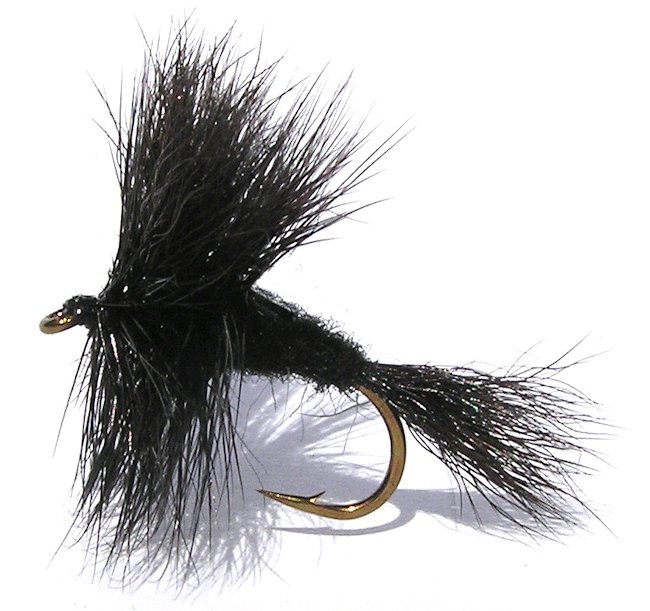The Black Wulff Dry Fly
Wulff also noted that dry flies with wings and tails of feathers get slimed up and are not very durable. To Wulff, the solution was obvious use bucktail (deerhair) for tails and wings. The mobility and buoyancy of elk and deer hair has made it a favorite North American fly tying material.

WULFF DRY FLY PATTERNS. Hook size 10 12 14 - $US each
WULFF DRY FLIES
The Wulff series of fly patterns were developed by Lee Wulff. It presents a bushy, high floating fly, that remains visible into the evening twilight, and rides well in rough water.
Every modern fly angler should have one or more of Lee Wulff's innovations. He designed and sold the first fly fishing vests, championed reeling with the left hand on fly reels (so the rod was in the stronger right hand), invented the first palming spool fly reels, introduced the fly-O casting practice rigs, popularized the "riffling hitch" for salmon fishing and designed the popular triangle taper lines. However, Lee Wulff's best-known innovations were in his flies.
Wulff patterns were the first flies to use hair for fly wings and tails. Almost all dry flies available in the winter of 1929/30 were, according to Wulff, anemic and too delicate, which he ascribed to their British tradition. The reason for very slim flies was that if a fly was too bulky the feather materials did not have the buoyancy to hold it up. A very popular pattern, for example, was the Fanwing Coachman that not only twisted the leader but also sunk at the tail due to the golden pheasant tail fibers used. Wulff also noted that dry flies with wings and tails of feathers get slimed up and are not very durable. To Wulff, the solution was obvious use bucktail (deerhair) for tails and wings. The mobility and buoyancy of elk and deer hair has made it a favorite North American fly tying material.
The first Wulff flies were tied to imitate the Isonychia (Gray Drake) and Green Drake hatches in the Catskills area of North East America. Wulff first fished these patterns with his regular fishing companion, Dan Bailey, who was then a science teacher in Brooklyn. In those early trials with these new patterns, Lee's was not disappointed. He found that the fish seemed to prefer the bulkier flies that "looked more" like the naturals than the more anemic patterns that were then popular. With respect to durability, the hairwing flies also excelled. Wulff reports he caught 51 trout on one Gray Wulff fly in an early outing, needing only to "grease up the fly for every 5-6 fish". The first patterns included the Gray Wulff, White Wulff and Royal Wulff. The Grey Wulff can be used to imitate any dark mayfly the trout are feeding on but when Lee Wulff was reportedly asked what the Royal Wulff was imitating he supposedly said, "Strawberry shortcake, something great big and juicy floating down to a large trout". It is an attractor pattern that is easily seen and high floating. It is a sweet little dessert that predatory fish find irresistible.
Later several other Wulff patterns, including the Grizzly Wulff, Black Wulff, Brown Wulff and Blonde Wulff were developed. Lee Wulff stated that these flies were a general kind of fly, not a particular pattern. When you first use Wulff flies treat with floatant and fish on the surface. Leave the fly to drift with the current. Occasionally accelerate it gently over short distances of a yard (meter) or more, or else twitch it to represent a struggling insect trapped in the surface film. They were first used in Britain in the 1950's but they saw very little service in Ireland until after 1990.

CUSTOMER'S PHOTO
Hi Craig, This is me fishing at Lake Clearwater in the Ashburton district lakes area of South Canterbury, South Island, NZ 28th January 2014, The fly, one of your "Black Wulff" dry flies. A lively brown trout as you can see! Your flies still bring me a lot of success! Tight lines, Tim Elms, New Zealand
FACEBOOK READER'S COMMENT
I tie Wulffs in size 6 and 4 . I use them in riffles when fishing for Smallmouth Bass. I tie white, black and grey Wulffs. David Sabo, Howell, Michigan, USA.
CUSTOMER'S PHOTO
Herve Raclot likes to catch perch by fly fishing in France. These four perch were
caught using a black Wulff hook size 14. The top left was 2.2kg and 52cm long. The top right was 1.7kg and 50cm long. The bottom left was 2kg 50cm long and the bottom right was 1.9kg 50cm long.


Fly Fishing books

